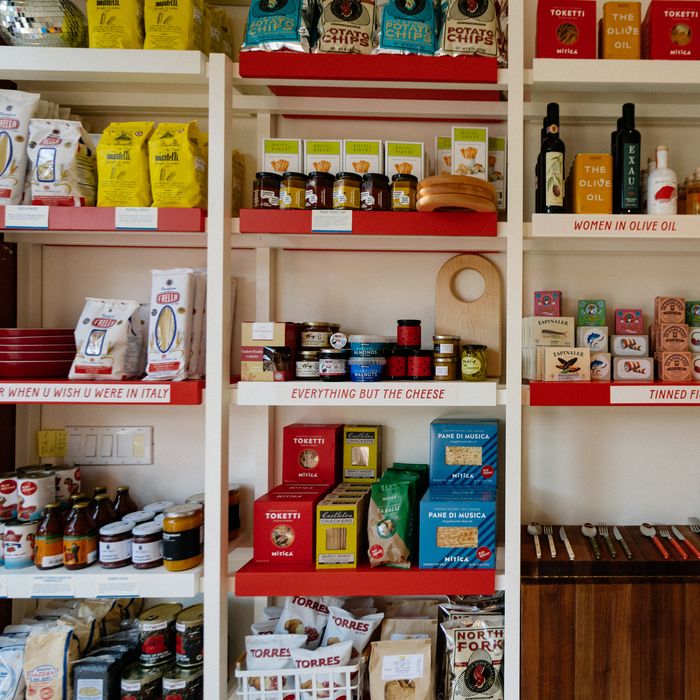At some point in the past couple of months, I began to wonder why my coffee shop was trying to sell me olive oil at 7:30 in the morning. You know the brand: It’s packaged in a cheerful green squeeze bottle with a comforting label that looks as if it could have been drawn by the same illustrator who did those Mr. Men books from the ’70s. It’s called Graza, and at the shop in question, it’s stocked next to clear jars of dried spices and colorful little tins of preserved fish.
Graza is only about a year old, but if you shop at a particular type of boutique grocer, you may feel like it’s always been here. That is part of the plan. “The small stores were very much a part of our launch strategy and go-to-market strategy,” said Allen Dushi, Graza’s COO. “We wanted to look like an online brand and smell like an online brand and talk like an online brand but build the business through retail.” Dushi founded Graza with Andrew Benin, who, according to his LinkedIn page, was previously head of special projects for the fancy cereal brand Magic Spoon and before that spent three years working for that mattress brand, the one everyone thought they loved a couple of years ago, which Dushi told me had directly informed Graza’s growth. “I think Andrew’s experiences at Casper — they saw the limits of what you can do just online,” he said. “It took most DTC brands a very long time to realize that they truly needed retail, and you’re seeing it happen more and more now.”
I scrolled to the bottom of Graza’s website to see where I could find the oil in Brooklyn. Among the dozens of names — and every Whole Foods location — I saw Good Friend in Gowanus, Poppy’s in Cobble Hill, Dépanneur in Williamsburg, and Big Night in Greenpoint.
Read the rest of this article at: Grub Street
From a distance, you might have mistaken them for teenagers, though they were in late middle age. It wasn’t just the miniskirts and heels on their slim frames, or the ponytails and flaming lipstick, but the girlish way the women held hands, stroked arms, massaged shoulders, smoothed sleeves and straightened bag straps, giddy with affection. Their makeup was heavy, with boldly pencilled brows, and their long hair tinted black or dyed brassy blond – recreating a youth that had never been theirs to enjoy.
Auntie Huang was wistful as we watched a couple of students stroll past in the grounds of Chongqing University, green with palms and willows and great thickets of bamboo. We had made ourselves at home in a little pavilion set upon the lake.
“Just like today’s young people, I wanted to do many things, like go to university, but I couldn’t,” she told me. “I was 18. I felt there was no hope. We had no hope at all. One person would cry and then everyone would start. It was dejection. Despair.”
In late 1968, the train and bus stations of Chinese cities filled with sobbing adolescents and frightened parents. The authorities had decreed that teenagers – deployed by Mao Zedong as the shock troops of the Cultural Revolution – were to begin new lives in the countryside. A tide of youth swept towards impoverished villages. Auntie Huang and her friends were among them. Seventeen million teenagers, enough to populate a nation of their own, were sent hundreds of miles away, to places with no electricity or running water, some unreachable by road. The party called it “going up to the mountains and down to the countryside”, indicating its lofty justification and the humble soil in which these students were to set down roots. Some were as young as 14. Many had never spent a night away from home.
Read the rest of this article at: The Guardian
I have a friend who works for a company that requires her to share a hotel room with a colleague when she travels on business. This is bad under any circumstances. It is especially bad if you’re sick, pregnant, congested, flatulent, somnambulant; if you’re a night owl or an early bird; if you have a medical condition necessitating privacy; or if you just prefer to spend your precious downtime bingeing “Love Is Blind” in a judgment-free zone. Being forced to see a co-worker in a towel or listen to her snore ought to be illegal. Despite raising obvious issues with sexual harassment and with the Americans with Disabilities Act, it is not.
Thankfully, there’s France, home of the right to ignore your e-mail on the weekend and the right not to eat at your desk. In another win for workplace dignity, one of the nation’s highest courts recently suggested that businesses cannot force their employees to participate in office parties and other supposedly enjoyable activities. The case dates back to 2015, when a man, known as Monsieur T., sued his former employer, the Paris-based management-consulting firm Cubik Partners, for wrongful termination. Monsieur T.’s demand for reinstatement was dismissed in labor court. An appeals court then found that Cubik had not erred in letting him go for, among other things, failing to take part in a workplace culture that the company calls, in a bit of corporate Franglish, “fun & pro.” In its recent decision, however, the high court overturned that ruling. Citing the European Convention on Human Rights and the French labor code, the court held that Monsieur T. had no obligation to attend retreats and Friday apéros. In fact, his bosses’ expectation that he join in violated his freedom of expression. Call it, as Arte did, “the right not to be fun.”
Read the rest of this article at: The New Yorker
Before Jason Ballard became an entrepreneur, he considered becoming a priest. His speech is still peppered with the idiom of faith—wicked, angels, sacred—and, when he latches on to a subject he cares about, he assumes a rousing, propulsive cadence. These days, the topic he is most evangelical about is our broken housing system. “What we’re doing is not working,” Ballard told me last spring. “There are far too many homeless people. Working-class people can’t afford basic housing in regular old American cities. Construction’s too wasteful. Houses aren’t energy-efficient enough. At the suburb scale, it’s dystopian, almost, what we’re getting, right? We’re supposed to be the most advanced version of humanity that’s ever existed and we can’t even meet this basic need properly. And that means the housing of our future can’t—not shouldn’t, but can’t—be like the housing we have now.”
In 2017, Ballard co-founded Icon, a construction startup focussed on what he believes to be a solution to the housing crisis: 3-D-printed construction, a largely automated method that creates buildings layer by layer, typically with cement-based material. The company has offices in the Yard, a mixed-use development in a formerly industrial area of Austin, Texas. The Yard is currently home to a sake company, a winery, a brewery, a canned-cocktail company, a hard-seltzer manufacturer, a whiskey distillery, and a Tesla dealership. On the morning I visited, the air was thick with the sweet-sour smell of fermentation.
Amid supply-chain issues, labor shortages, and the rising cost of construction materials, there has been a surge of interest in novel ways of building, and Icon has grown accordingly. Five years ago, fewer than ten people worked at the company; now it employs more than four hundred. Ballard, who is forty and has bright eyes and a guileless, open face, met me in a narrow conference room. Placards on the wall read “Courage,” “Ambition,” and “Velocity.” He wore a black Patagonia jacket embroidered with the company’s name and, as he often does, a white cowboy hat.
Read the rest of this article at: The New Yorker
In a TikTok video she made to promote Liftoff, her beginners’ step-by-step weight-lifting manual, fitness writer Casey Johnston demonstrates the way she used to pick up a 40-pound box of kitty litter and carry it into her apartment. In this “before” scene, she goes through a series of painfully familiar contortions, scuttling, scrambling, and finally pushing the box through the door wheelbarrow style, butt in the air. The “after” video is about two seconds long; Johnston simply reaches down, picks up the box, and carries it inside.
The clip is simple but encapsulates what makes Johnston such an effective teacher, one who has convinced her readers that bulking up, not slimming down, is a worthy fitness goal: her willingness to put her imperfections on display to get her message across, her commitment to the quotidian benefits of lifting, and her body, which is, as you would expect from the author of an advice column called Ask a Swole Woman, commendably swole.
Since 2016, when she started writing the column, Johnston has been amassing an army of (presumably somewhat swole) followers. Readers migrated with her from the Hairpin to Self magazine, then to Vice, then to Johnston’s independent newsletter, She’s a Beast. Navigating the world of journalism hasn’t always been easy for Johnston, as you might guess from her column’s four-homes-in-six-years trajectory. In a previous media era, a voice-y expert with an established following might have spent 20 years writing for the same magazine; Johnston has had to be nomadic, then entrepreneurial. In the process, she became a self-publishing success story: Her newsletter has 21,000 subscribers, and Liftoff has sold 11,000 copies at $20 a pop.
No one whom Johnston spoke to in traditional publishing thought the book would sell. Agents and editors couldn’t wrap their heads around how to present the material. “‘Have you thought about making an app?’” Johnston says one of them asked her. “I was like, Good Lord.”
What makes Liftoff different from other books of its genre, besides Johnston’s charming voice and lightly worn expertise, is how she breaks down moves as plainly as possible. “I’ve read textbooks explaining how to lift weights, and it’s brain melting,” she says. So in her book, there’s no exercise physiology, no anatomical diagrams. Instead, there are straightforward descriptions of how to safely move weights from one relationship with gravity to another, plus links to YouTube videos of herself doing the moves.
Read the rest of this article at: The Cut








